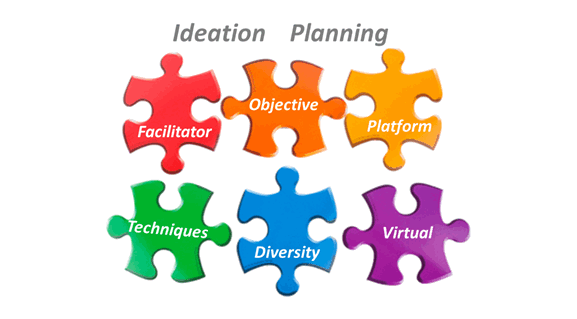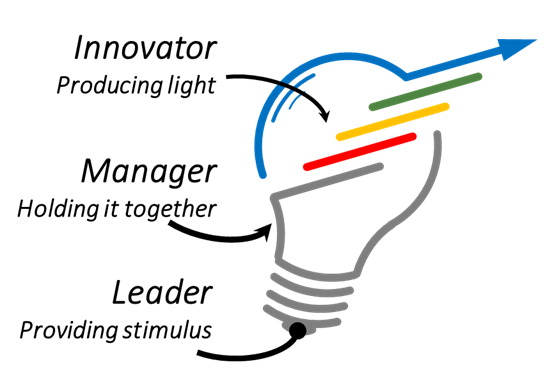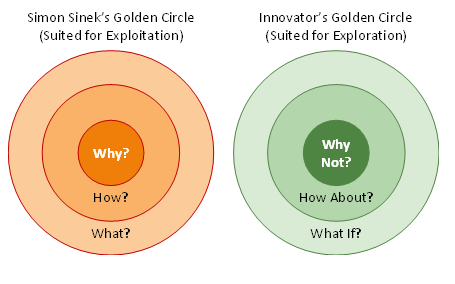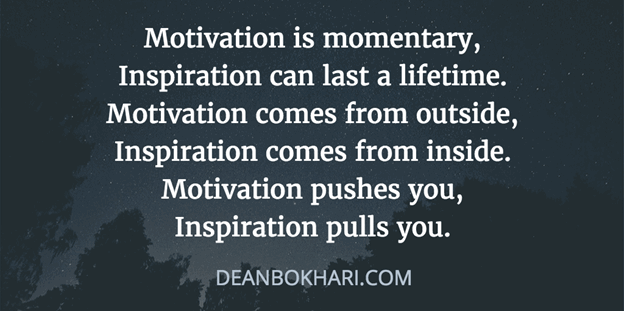Really?
Out-Of-The-Box ideation still needs a well-boxed upfront planning, an expert facilitator, and a disciplined approach to post processing.
Planning an Ideation Session involves these steps.

Objective(s)
While you need out-of-the-box thinking during the ideation session, you need a fairly well-defined box when it comes to defining the challenge problem or the objective of the session. These objectives can be at any level – purpose, strategic, tactical, operational, project subject matter, etc. The objectives are typically focused on how and/or what; and occasionally on discovering the purpose (why). Some examples include …
- How can we save corals and marine life from chemical waste (purpose)?
- How do we use Industry 4.0 for the development of a special child (purpose)?
- How to go through digital transformation in the next 3 years (strategic)?
- What will be the impact of industry 4.0 on our business (strategic)?
- How to grow the business by 5X in 5Years (strategic)?
- How to expand the market in the Asia Pacific region (tactical)?
- How can we design a compact high temp storage box (technical)?
- How to reduce the component weight by 22% (technical)?
- How to recover from schedule variance (operational)?
- What can we do to help the customer accelerate production (tactical)?
- What set of technologies can we develop for a smart home market (technical/strategic)?
If the objective is too large or broad, then I suggest a series of sessions, structured hierarchically. A theme (from a cluster of ideas) at the strategic level becomes an objective at the tactical level. For example, the executive team gets together for an ideation session with the objective ‘How to grow the business by 5X over the next 5 years?’ The outcome is a set of 6 idea themes, and 4 of them become follow-up ideation objectives.
- Objective: How to grow the business by 5X in 5Years (strategic)?
- Sub-objective 1: Adapt Industry 4.0?
- Launch an Artificial Intelligence enabled service.
- Offer augmented reality-based training.
- Sub-objective 2: Expand the business into the Asia Pacific region.
- Set up a partnership with a university in Singapore.
- Acquire and turnaround a struggling small business in India.
- Sub-objective 3: Scout & acquire training company on ISO9001.
- Sub-objective 4: How will Amazon/Google impact our business.
- Sub-objective 5/6: Not worth pursuing.
Every objective statement should have a unique topic-owner. The facilitator and the topic owner should be empowered to modify the problem statement within a narrow boundary.
Given that we are in the middle of the 4th industrial revolution, every company today should run ideation sessions with these types of objectives.
- What are the opportunities or threats from industry 4.0 technologies?
- What company values will drive our socio-economic development?
- What ideas or industry 4.0 technologies can help us create value for the society; or perhaps help in progress towards UN’s SDGs?
- What new skills do we need to thrive through this transformation?
- What new business models may bring us additional value or stability?
Companies such as Amazon, Apple, Facebook, and Google, are on a roll to change the world. Their moves can suddenly disrupt your business, and ideation around those is important, just like you plan your house for storms, well in advance.
As we emerge out of the Coronavirus pandemic, some plausible ideation objectives could be …
- How will consumer behavior change in the next 3 to 5 years?
- What is the impact of unemployment surge to long-term demand for your products and services?
- Which markets will disappear for you and which ones will expand rapidly?
Ideation objectives have a strong linkage with the innovation profile.
Agile Followers define ideation objectives based on VOC or RFP.
Smart Forecasters defined their objectives based on anticipated needs.
Visionary Trendsetters pick up a social or professional white space and often take a moon shot.
Identification of funding sources can be a part of the ideation exercise. Care should be taken not to use that as an excuse to pre-screen some good ideas.
I normally prefer to keep funding conversation as a follow-on topic.
Facilitator
The most important member in an ideation session is the facilitator. A good facilitator has some knowledge of the subject matter without bias in favor of any outcome, is a good communicator, is assertive in managing the group dynamics, is respectful of group diversity, can scribe inputs and engage with individuals at the same time, and has a sense of humor. Most importantly a competent facilitator understands multiple ideation techniques and tricks to continuously trigger fresh ideas.
Innovation coaches often make good ideation facilitators, unlike innovation management consultants. A consultant solves the problem, whereas a coach helps build your competency to solve the problem. An ideation session facilitated by a coach provides the team with techniques to generate and refine ideas, which are useful after the session is over.
Diversity
Sometimes, you may feel that you can generate ideas faster when you work alone. However, if you want creativity, resist that temptation. Do it as a group, preferably a diverse group. Diversity of skills and roles is a key design element. There is no ‘right size’ for the group, but in my experience 5-15 people is the sweet spot. There is no perfect composition of the group. I typically start with a core group of product/service developers and business development personnel who will have to later execute. I always suggest bringing in an IT person (it is the digital age after all) and a student/intern (who can have wild thoughts). Sometimes, I add a finance person to put some reality into the solutions. Diversity in thinking is required, and often comes with diverse demographics and past experiences.
It is also important to keep a few elements out of the session. I try to keep idea-killers, naysayers, and heavyweight executives out of the session, whose presence may intimidate participants. If a particular senior staff member insists on participating, then it is an indicator to exclude them (!). A smart facilitator may compensate for such undesirable engagement, but I do not count on it.
Ideation Techniques
There are several ideation techniques, and research on the topic is producing new methods and tricks all the time. Bryan Mattimore has compiled over 20 of these in his book[1], which I would say is a must-read for all ideation facilitators. My preferred ones are ‘I Wish’, ‘Visual Triggers’, and ‘Brain Walking’.
Based on the objective and participants, the facilitator should select a primary and couple of supplementary ideation techniques for the session, and plan on training the participants on the techniques. The choice of technique depends upon group size, facilitator understanding of the technique and the objective as well.
Platform
It is best to conduct an ideation session in a new setting, preferably a stimulating ambiance, with articles that can provide visual triggers, such as unconventional furniture, lighting, toys. Keep an ample amount of wall space to display growing content. And of course, an unlimited supply of water, coffee, and fresh fruits or preferred refreshments. It is important to be relaxed and not distracted by smartphones. I have seen some superb ideas hit the happy hour table once the formal sessions are closed out. There is no reason to exclude that additional input.
Again, there is no single answer to how long should this be scheduled. I typically plan for 2-4 hours for a fairly well-defined objective, depending upon the group size. Sometimes, a full-day is warranted, anything beyond that is likely to produce diminishing results and calls for a hierarchical session set.
Going Virtual
With current social distance restrictions, some of the ideation techniques have become even more powerful with online or virtual engagements. Tools such as SessionLab, Stormboard, IdeaFlip, Sprintbase, InVision, Mural, Miro, and others have found useful applications. If you do not have any of these traditional Excel over Zoom with whiteboard also works well. Over the last year, we have also successfully worked through multiple sessions in lieu of full day offsite to avoid ‘zoom fatigue’ and use the time in between to gather meaningful data.
In Summary,
Ideation is more than brainstorming. Multiple factors need to be considered in upfront planning to extract the best out of participating brains. The leadership should define the objective and pick the facilitator and let the facilitator pick the participants, platform, and techniques.
If you like this blog post, you will like my book – “Inspiring Next Innovation Value Chain” available on Amazon.
If you wish to engage with me in a conversation, on this topic, please register for an online session on Feb 25, 2021 at 9AM ET co-hosted by Nerac.
[1] Idea Stormers – How to Lead and Inspire Creative Breakthroughs; Bryan W. Mattimore; Book, 2012.




